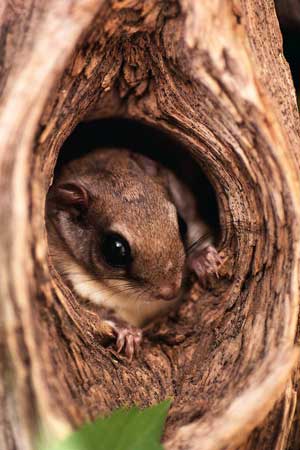A standing dead or nearly dead tree is called a “snag.” One of my all time favorite snags is located near Amarillo Texas. The “First Tree of the Panhandle” was planted in 1888 by a husband attempting to mollify his homesteading wife, who complained of the monotony of the barren high plains. It was the only tree for miles around and became a local landmark. It managed to survive droughts, blizzards, summer heat and sandstorms. Ironically, it was nailed in 1969 by an unfortunate aerial herbicide application. The deceased tree was left in place because of its historic significance. But in an era of manicured lawns and orchards, and clear cut logging, many snags are cut down, and dead branches are trimmed. So why is this a problem?
 |
Nocturnal Flying Squirrels often sleep in snags during the daytime. These standing dead trees provide living quarters, refuge and food for wildlife. |
Snags supply living quarters and refuge for wildlife. The trunks and roots of snags in rivers and streams act as critical shelter and spawning sites for fish. Birds and creatures like brown bats and peepers often roost in cavities for protection from the elements and predators. Woodpeckers, owls, wood ducks and flying squirrels rely on cavities for nesting (thus qualifying snags as “sexy.”)
While artificial nestboxes enable species like bluebirds to compete with the more aggressive starlings, some birds like nuthatches prefer the real thing. Pileated woodpeckers seek trees that are an average of 32” in diameter. The US Dept. of Agriculture notes that “Reliance on bird boxes requires the placement of many types and sizes of nest boxes at various heights and densities throughout the forest. The boxes must be constructed, installed, cleaned and replaced periodically. The cost would be formidable and the results probably less successful than if snags were present.”
Snag and den trees also provide food for a wide variety of animals. “Den trees,” which have hollow trunks and/or limbs, are often alive and may continue to produce fruits or nuts (called “mast.”) Also, insects are attracted to decaying trees. Even-aged, young softwood tree stands do not support many different kinds of insects compared to older growth, which means fewer birds and mammals. Reducing insect-eating wildlife populations can seriously affect a forest’s ability to withstand insect attacks in the future.
So instead of automatically felling and removing snags:
- Leave an average of seven snag/den trees per acre, evenly distributed throughout your property. Trees larger than 8” diameter at breast height are the most valuable for cavity nesters.
- Practice sustainable forestry and selective thinning. When properly utilized, patch cutting is a valuable wildlife management tool that creates young, brushy habitats essential to many species.
- Leave some logs or large fallen trees on the ground. They offer perches for hawks and squirrels; and loads of insects and other invertebrates for wildlife to eat.
Of course, if a snag or dead limb poses a safety hazard – e.g., because it is hanging over a path, building or electrical lines - it should be removed. In some cases, a diseased limb threatens a living tree and needs to be trimmed. Consult a licensed arborist for advice and assistance in safely removing or saving trees.
MORE INFORMATION:
|

